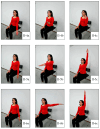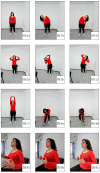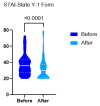The Effect of Mild Exercise in the Chemotherapy Room on the Anxiety Level of Cancer Patients: A Prospective Observational Paired Cohort Study
- PMID: 40807210
- PMCID: PMC12347337
- DOI: 10.3390/jcm14155591
The Effect of Mild Exercise in the Chemotherapy Room on the Anxiety Level of Cancer Patients: A Prospective Observational Paired Cohort Study
Abstract
Background/Objectives: Cancer represents a significant health challenge, with high mortality and morbidity rates. Its diagnosis often triggers chronic stress, adversely affecting patient outcomes. Exercise has emerged as complementary therapy, enhancing treatment adherence and mitigating the side effects of chemotherapy. This study examines the effects of mild exercise during chemotherapy on patient anxiety. Methods: This prospective paired cohort study was conducted in the General Oncology Hospital of Kifisia "Agioi Anargyroi" in Athens, Greece. Adult cancer patients undergoing chemotherapy participated, excluding those with cognitive, hearing, or motor impairments, those who experienced side effects, or those who declined consent. Anxiety was measured before and after a 20-minute exercise routine performed during chemotherapy, using the Greek-translated State-Trait Anxiety Inventory (STAI). The exercise regimen included warm-up, full-body stretching, and cool-down exercises. Pre- and post-exercise scores were analyzed using the Wilcoxon signed-rank test. Results: Forty-five patients (20 women, 25 men; mean age 69.02 ± 10.62 years) with various cancer backgrounds participated. Pre-intervention anxiety levels were in the borderline "moderate" range, dropping post-exercise to the "low" range. Mean STAI scores decreased from 37.73 ± 13.33 to 32.00 ± 14.22 (p < 0.0001), with a medium-large effect size (Cohen's d for paired samples = -0.646). No significant correlation was found between age and anxiety scores. Discussion: This study found a significant short-term reduction in anxiety, suggesting that incorporating mild exercise during chemotherapy may help in alleviating patient stress. The medium-to-large effect size supports the potential for meaningful short-term benefits. Conclusions: Incorporating mild exercise during chemotherapy may help reduce anxiety and psychological burden. These findings underscore the need for more comprehensive research in larger, more diverse populations to better understand the benefits of incorporating mild exercise during chemotherapy.
Keywords: anxiety; chemotherapy; exercise therapies.
Conflict of interest statement
The authors declare no conflicts of interest.
Figures








Similar articles
-
Prescription of Controlled Substances: Benefits and Risks.2025 Jul 6. In: StatPearls [Internet]. Treasure Island (FL): StatPearls Publishing; 2025 Jan–. 2025 Jul 6. In: StatPearls [Internet]. Treasure Island (FL): StatPearls Publishing; 2025 Jan–. PMID: 30726003 Free Books & Documents.
-
Physical exercise training interventions for children and young adults during and after treatment for childhood cancer.Cochrane Database Syst Rev. 2013 Apr 30;(4):CD008796. doi: 10.1002/14651858.CD008796.pub2. Cochrane Database Syst Rev. 2013. Update in: Cochrane Database Syst Rev. 2016 Mar 31;3:CD008796. doi: 10.1002/14651858.CD008796.pub3. PMID: 23633361 Updated.
-
Physical exercise training interventions for children and young adults during and after treatment for childhood cancer.Cochrane Database Syst Rev. 2016 Mar 31;3(3):CD008796. doi: 10.1002/14651858.CD008796.pub3. Cochrane Database Syst Rev. 2016. PMID: 27030386 Free PMC article.
-
Breastfeeding interventions for preventing postpartum depression.Cochrane Database Syst Rev. 2025 Feb 18;2(2):CD014833. doi: 10.1002/14651858.CD014833.pub2. Cochrane Database Syst Rev. 2025. PMID: 39963955
-
Exercise interventions on health-related quality of life for people with cancer during active treatment.Cochrane Database Syst Rev. 2012 Aug 15;2012(8):CD008465. doi: 10.1002/14651858.CD008465.pub2. Cochrane Database Syst Rev. 2012. PMID: 22895974 Free PMC article.
References
-
- Jacques F., Majid E., Florence L., Matthieu L., Mireille C., Les M., Mariana P., Ariana Z., Isabelle S., Freddie B. Global Cancer Observatory: Cancer Today. International Agency for Research on Cancer; Lyon, France: 2024. [(accessed on 22 July 2025)]. Available online: https://gco.iarc.who.int/today.
LinkOut - more resources
Full Text Sources

